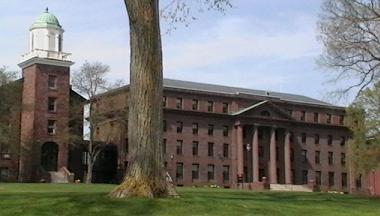Rankings of Top-Tier Liberal Arts Colleges
The liberal arts are those fields that cultivate intellectual ability rather than technical or professional skills. The term “Liberal Arts & Sciences” has been used since the advent of the medieval European university, when the seven liberal arts were taught in two groups: the trivium, which included grammar, logic, and rhetoric, and the quadrivium, which included arithmetic, geometry, astronomy, and music. Today, in our institutions of higher learning, liberal arts fosters a wide-ranging understanding of the arts, sciences, and humanities. Within a liberal arts program, a student can study languages, music, English, anthropology, history, women’s studies, psychology, mathematics, sociology, philosophy, political science, economics, and a number of other disciplines.
Many high school students aspire to study the liberal arts at a public or private university, but others who seek a top liberal arts education aim for admission to one of the small but highly regarded liberal arts colleges. These schools appeal to many students the following reasons:
- Focus on undergraduate studies (most liberal art colleges have no graduate programs)
- Small and cohesive campus community
- Often located in bucolic or small city settings
- Students participate in a wide range of activities
- Small student population (the top 10 schools listed below in the U.S. News & World Report rankings average 1,929 undergraduates)
- Small class sizes
- Excellent access to faculty
- Emphasis on critical thinking
- Educational requirements are well rounded
In the founding tradition of American education, liberal arts colleges require students to develop a firm grounding in the liberal arts and, more specifically, the humanities. The humanities, as the term implies, is the study of the human condition from different perspectives. In the U.S., the fields that comprise the humanities are listed in Table A:
Table A: Fields of Study That Comprise the Humanities
| Anthropology | Classical Languages and Culture | History |
| Geography | Linguistics and Foreign Languages | Performing Arts |
| Literature | Law, Government, and Public Policy | Philosophy |
| Theology | Writing and Grammar – English | Visual Arts |
Liberals arts colleges contravene the strong recent movement in American education to lighten requirements in the liberal arts in order to allow for more courses that support majors in the Science, Technology, Engineering, and Technology (STEM) fields. This trend is the result of the perception held by many education professionals that required courses in the humanities in lieu of STEM courses might lessen the future employability and income potential of graduates.
The factors that have driven some students, often against their desires and best interests, away from the humanities have been exaggerated. The diminution of the role of the liberal arts has been greatly exaggerated. The proportion of students majoring in the humanities did decline from 1970 to 1995. However, the percentage since then has been remarkably steady at about 10% of total undergraduate degrees. Perhaps what has induced the perception of decline is that, in percentages of humanities graduates, elite institutions like Berkeley, Yale, and Cornell have gone from exceptionally high levels to merely above average.
Historically, the rationale for the founding of American colleges was not to train students for a specialized career in a specific field. Rather, the guiding philosophy was that exposure to a broad intellectual tradition was necessary as the basis for leadership in communities, commerce, and the professions. Although this approach may now seem naïve and unrealistic in a society as complex and technologically advanced as ours, a common set of humanities requirements still benefits students regardless of what profession they enter.
Like other types of universities and colleges, several popular publications rank private liberal arts colleges. Below are the top ten institutions for 2018-2019 from three resources; U.S. News & World Report, Forbes, and the New York Times.
Table B: Rankings of Best Liberal Arts Colleges 2018-19
| Rank | U.S. News & World Report | Rank | Forbes | Rank | New York Times |
| 1 | Williams | 1 | Pomona | 1 | Amherst |
| 2 | Amherst | 2 | Claremont McKenna | 2 | Williams |
| 3 (tie) | Swarthmore | 3 | Williams | 3 | Pomona |
| 3 (tie) | Wellesley | 4 | Amherst | 4 | Wellesley |
| 5 (tie) | Bowdoin | 5 | Harvey Mudd | 5 | Swarthmore |
| 5 (tie) | Carlton | 6 | Swarthmore | 6 | Claremont McKenna |
| 5 (tie) | Middlebury | 7 | Bowdoin | 7 | Carlton |
| 5 (tie) | Pomona | 8 | Haverford | 8 | Middlebury |
| 9 | Claremont McKenna | 9 | Washington & Lee | 9 | Haverford |
| 10 | Davidson | 10 | Wesleyan | 10 | Smith |
For the most part, the three sources reflect only variations in the rankings of the same set of schools. Exceptions that appear on only one of the lists include Davidson on the U.S. News & World Report list, Washington & Lee, Wesleyan, and Harvey Mudd on the Forbes list, and Smith on the New York Times list.
The good jobs of the future will go to those who can collaborate widely, think broadly, and challenge conventional wisdom — precisely the capacities that an education in the liberal arts develops — so don’t be discouraged from pursuing knowledge in the field that you truly love.
IvySelect, as a premiere college admissions consulting firm, will guide you in defining your educational path, both in your choice of major and “best fit” target schools. We assist students who aspire to attend Ivy League and other elite institutions, including top-tier liberal arts colleges. We have successfully assisted students in gaining admission to Williams, Amherst, Swarthmore, Wesleyan, Vassar, Bowdoin, Middlebury, Haverford, Wellesley, Barnard, Colgate, Hamilton, and more.





